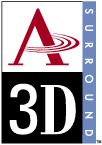Van Nuys, CA. George Massenburg, founder of George Massenburg Labs (GML), has announced that he is reorganizing his company to focus on new marketing, manufacturing and product support initiatives.
At the recent AES ’96 show in Los Angeles, Massenburg Labs introduced two new outboard modules, a parametric EQ and a digital noise filter, in keeping with the new strategy.
“These new products were entirely market-driven,” says Massenburg. “We just listened to what engineers asked us to make.”
The GML 9500 Dual Channel 5-Band Parametric Mastering Equalizer is an all-discrete design, similar to the SML 8200, will known for its detail, transparency, and headroom, as well as its broadly overlapping EQ bands. It differs from the 8200 in that all of its controls a fully detented, with frequencies accurate to 0.5% and levels to plus/minus 0.10dB. This makes the new unit ideal for tasks that require precise control and resetability, such as mastering. The 9500 fits a 3U 10″ rack space, and it will be priced at $9,500 (US). It will ship in the first quarter of 1997.
The GML 9550 Digital Noise Filter is also a rack-mount unit, supplied with a desktop controller. It’s a two-channel processor with digital I/O in AES/EBU, S/PDIF and Toslink optical formats. 8 front-panel controls adjust the threshold for each of eight bands from -96dB to 0dB. The 9550 was developed jointly with the Walt Disney Company, originally intended for enhancing sound in film post production, particularly the removal of noise from archival sources. It has specific applications in the restoration of deteriorated sources in music production, but it is also suitable for general removal of low- and medium-level noise artifacts. the 9550 is priced at $9,500 (US), and it is available now.
As well as introducing new products, GML has geared up to ship all of its established niche products in larger volume, including the 8200 EQ, the 8900 Dynamics Controller, and the HRT 9100 Mixing System. While beefing up the retail channel, GML will continue to upgrade its console automation systems, and carry on with custom product development for major pro audimanufacturers.
“Reorganization at GML is intended to better serve the industry,” says Massenburg. “We’ll have more new product announcements to make in the very near future.”
 Aureal Semiconductor won good reviews for the sound quality of its chip set when it was demonstrated at the AES Convention, and the company is getting a similar response from the less-discriminating (audio-wise) audience at COMDEX. The chip set features Aureal’s ASP301, an optimized DSP engine that provides the company’s Aureal 3D (A3D) spatialization and accelaration support of the DirectSound API; and the ASP311 PCI bus interface chip. The chip set is positioned as an OEM upgrade to existing Sound Blaster cards.
Aureal Semiconductor won good reviews for the sound quality of its chip set when it was demonstrated at the AES Convention, and the company is getting a similar response from the less-discriminating (audio-wise) audience at COMDEX. The chip set features Aureal’s ASP301, an optimized DSP engine that provides the company’s Aureal 3D (A3D) spatialization and accelaration support of the DirectSound API; and the ASP311 PCI bus interface chip. The chip set is positioned as an OEM upgrade to existing Sound Blaster cards. Also at COMDEX, VLSI Technology Inc. introduced its SongBird 3D™ DirectSound Accelerator chip (VL82C829), featuring VLSI’s ActiSound™ positional 3D audio. Like the Aureal chip, this one functions as part of a set. The main SongBird processor is the DSP HRTF engine, with interfaces to Dolby AC3 and MPEG audio processors, plus a separate AC’97 codec made by Sigma Tel.
Also at COMDEX, VLSI Technology Inc. introduced its SongBird 3D™ DirectSound Accelerator chip (VL82C829), featuring VLSI’s ActiSound™ positional 3D audio. Like the Aureal chip, this one functions as part of a set. The main SongBird processor is the DSP HRTF engine, with interfaces to Dolby AC3 and MPEG audio processors, plus a separate AC’97 codec made by Sigma Tel.